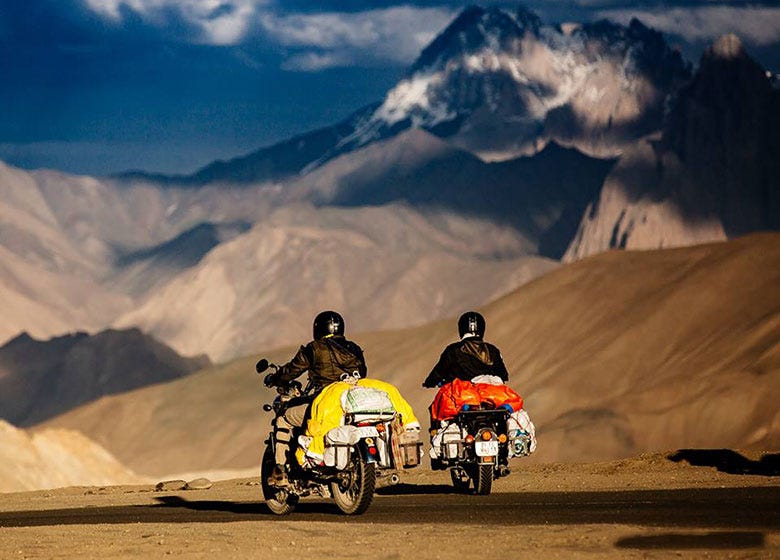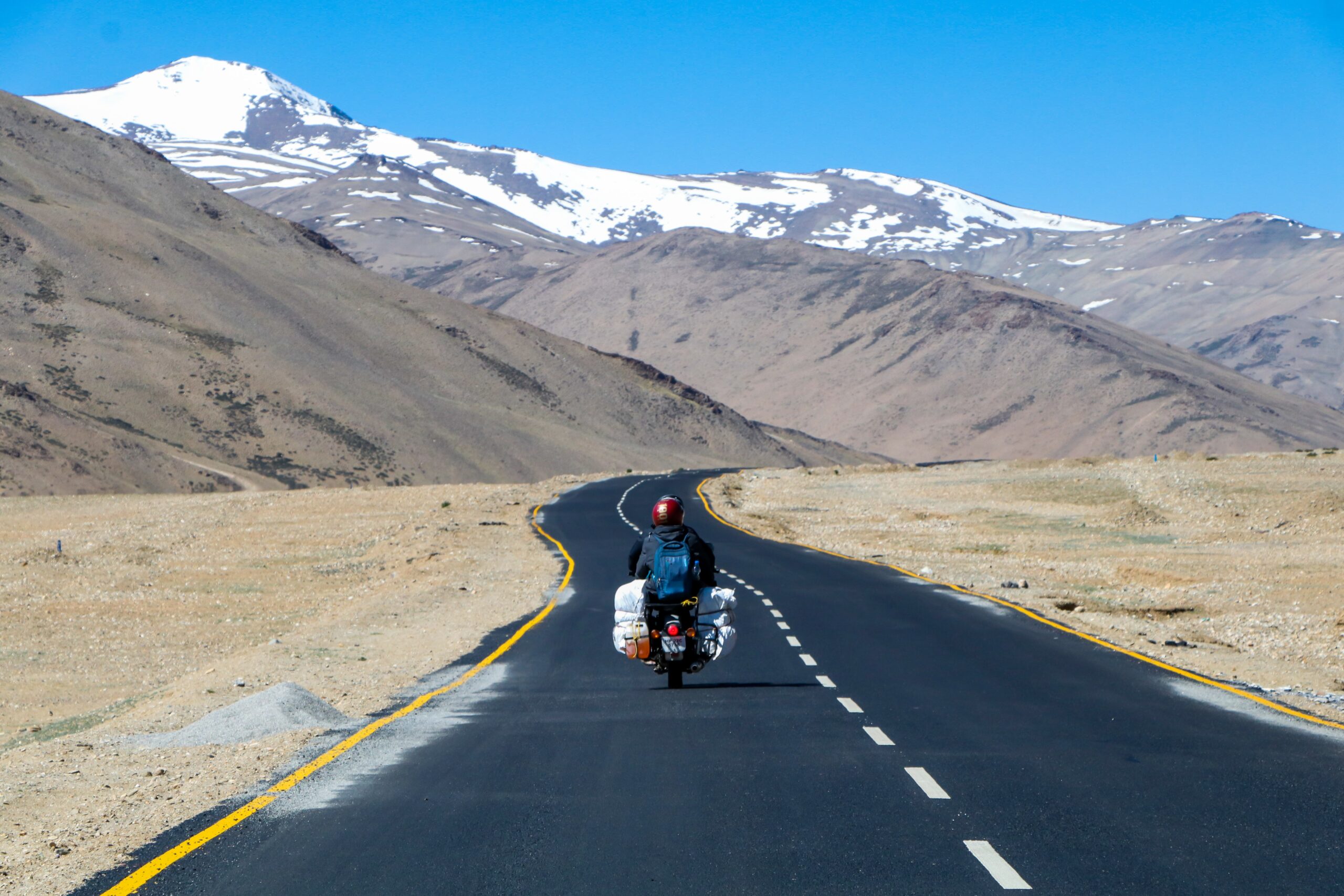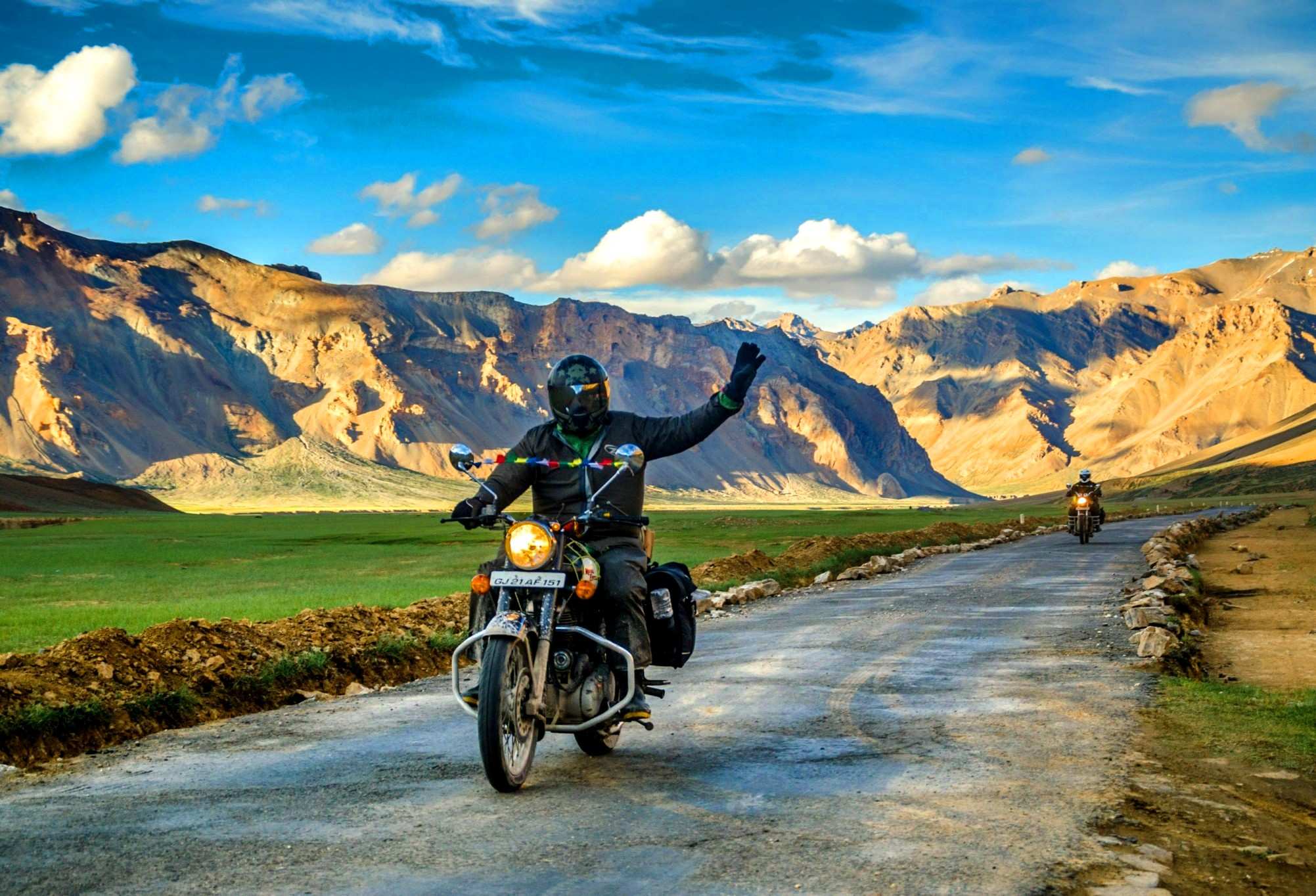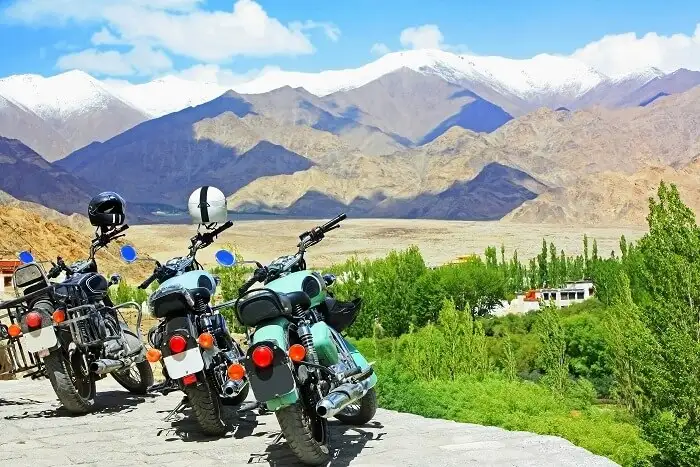A Ladakh bike trip is a thrilling adventure that allows you to explore the mesmerizing landscapes of the Ladakh region on two wheels. Ladakh, located in the northernmost part of India, is known for its stunning mountains, high-altitude deserts, pristine lakes, and ancient monasteries. The journey is not only about reaching your destination but also about experiencing the journey itself, as the landscapes are breathtaking and the terrain can be challenging.
Here are some key aspects to consider for a Ladakh bike trip:
- Route Planning:
- Popular starting points for Ladakh bike trips are Manali and Srinagar. Both routes offer scenic beauty, but the Manali-Leh highway is known for its challenging terrain and high mountain passes.
- Some major passes you will encounter include Rohtang Pass, Baralacha La, Lachung La, and Tanglang La.
- Plan your route carefully, considering the altitude and acclimatization needs.
- Permits:
- Certain areas in Ladakh, especially near the border with China, require permits for tourists. Check the latest regulations and obtain the necessary permits before starting your trip.
- Altitude Sickness:
- Ladakh is at a high altitude, and altitude sickness can be a concern. Acclimatize yourself by spending a day or two in Leh before heading to higher altitudes.
- Stay hydrated and avoid overexertion. If symptoms of altitude sickness persist, descend to a lower altitude.
- Equipment and Gear:
- Ensure your bike is in good condition for the challenging terrain. Carry basic tools, spare parts, and a repair kit.
- Dress in layers and carry warm clothing, as temperatures can vary widely. Don’t forget rain gear, as weather conditions can change rapidly.
- Accommodation:
- Accommodations can be limited in some remote areas, so plan your stays in advance.
- Camping is a popular option, but be aware of the environmental impact and follow responsible camping practices.
- Fuel and Supplies:
- Fuel stations are sparse in certain areas, so carry extra fuel. Plan your fuel stops accordingly.
- Stock up on essential supplies, as markets can be infrequent in remote regions.
- Health and Safety:
- Have a basic first aid kit and any necessary medications.
- Mobile network coverage can be unreliable in remote areas, so have a backup communication plan.
- Respect Local Customs:
- Ladakh has a rich cultural heritage. Respect local customs and traditions, especially around monasteries and religious sites.
- Weather Conditions:
- Check the weather conditions before your trip and be prepared for temperature extremes, especially in high-altitude regions.
- Travel in Groups:
- Traveling in a group can enhance safety and provide support in case of emergencies.
A Ladakh bike trip is a thrilling adventure that allows you to explore the mesmerizing landscapes of the Ladakh region on two wheels. Ladakh, located in the northernmost part of India, is known for its stunning mountains, high-altitude deserts, pristine lakes, and ancient monasteries. The journey is not only about reaching your destination but also about experiencing the journey itself, as the landscapes are breathtaking and the terrain can be challenging.
Here are some key aspects to consider for a Ladakh bike trip:
- Route Planning:
- Popular starting points for Ladakh bike trips are Manali and Srinagar. Both routes offer scenic beauty, but the Manali-Leh highway is known for its challenging terrain and high mountain passes.
- Some major passes you will encounter include Rohtang Pass, Baralacha La, Lachung La, and Tanglang La.
- Plan your route carefully, considering the altitude and acclimatization needs.
- Permits:
- Certain areas in Ladakh, especially near the border with China, require permits for tourists. Check the latest regulations and obtain the necessary permits before starting your trip.
- Altitude Sickness:
- Ladakh is at a high altitude, and altitude sickness can be a concern. Acclimatize yourself by spending a day or two in Leh before heading to higher altitudes.
- Stay hydrated and avoid overexertion. If symptoms of altitude sickness persist, descend to a lower altitude.
- Equipment and Gear:
- Ensure your bike is in good condition for the challenging terrain. Carry basic tools, spare parts, and a repair kit.
- Dress in layers and carry warm clothing, as temperatures can vary widely. Don’t forget rain gear, as weather conditions can change rapidly.
- Accommodation:
- Accommodations can be limited in some remote areas, so plan your stays in advance.
- Camping is a popular option, but be aware of the environmental impact and follow responsible camping practices.
- Fuel and Supplies:
- Fuel stations are sparse in certain areas, so carry extra fuel. Plan your fuel stops accordingly.
- Stock up on essential supplies, as markets can be infrequent in remote regions.
- Health and Safety:
- Have a basic first aid kit and any necessary medications.
- Mobile network coverage can be unreliable in remote areas, so have a backup communication plan.
- Respect Local Customs:
- Ladakh has a rich cultural heritage. Respect local customs and traditions, especially around monasteries and religious sites.
- Weather Conditions:
- Check the weather conditions before your trip and be prepared for temperature extremes, especially in high-altitude regions.
- Travel in Groups:
- Traveling in a group can enhance safety and provide support in case of emergencies.
Day 1: Delhi to Manali By Volvo Bus
Day 2: Manali Acclimatization day & Test Drive
Day 3: Manali to Sarchu
Day 4: Sarchu to Leh
Day 5: Leh Sightseeing
Day 6: Leh to Nubra Valley
Day 7: Nubra valley to Pangong lake
Day 8: Pangong lake to Leh
Day 9: Departure from Leh
Day 1-Delhi – Manali (Ladakh bike trip)
Reach Delhi by 02.00 PM. And, Leave Delhi by 6-7 PM and reach Manali by the next morning.
Reporting Point: Majnu Ka Tilla
Distance: 530 KM || 12 to 14 Hrs
Altitude: Delhi (700 ft) to Manali (6,398 ft)
Stay: NA
Day 2-Manali Acclimatization Day (Ladakh bike trip preparation)
Reach Manali & Move to our stay in Manali. This day is for Acclimatization Day. You can explore around the stay which is surrounded by apple orchids and walk to the Beas river and spend some time near the Beas river.
Paragliding in Manali:
You can plan Paragliding at an extra cost of 2500/- (Need to be informed at least one day before so that we can avoid Queue). We have a contract with the paragliding team for the best price. For others, the paragliding charges are INR 3,200/-
Swim in hot springs at Manali:
After the test ride, we will go to the hot springs for swimming. This really helps our bodies to settle down. Sulfur in hot springs water is good for the bones. You can also try the local mutton near hot springs at a popular restaurant. After a relaxing experience, we will head to Manali mall road.
Manali mall road visit:
We will spend enough time at Mall road for complete exploration also we have time for local shopping. Cafe hopping is one of the best things to do in Manali mall road for tasting local cuisine. We will go to the hotel after the exploration of Manali mall road.
Stay: Manali (Hotel)
Vehicle: 4 Wheeler
Altitude: Manali (6,398 ft)
Stay: Manali (Hotel)
Day 3-Manali – Solang Valley - Atal Tunnel – Sissu - Keylong – Jispa - Darcha – Baralacha La – Sarchu (Ladakh trip from Manali starts today)
After a healthy breakfast at our, We will start very early and start our ride towards Sarchu and enter the greater Himalayan landscape.
We will enter into Lahaul leaving Kullu behind using the Atal Tunnel The lush green grasslands disappear and the barren slopes of the cold dessert take over.
After crossing Darcha we will keep riding on Manali – Leh Highway towards Sarchu.
Visit Suraj Taal and Deepak Taal, two breathtaking high-altitude lakes in the Lahaul and Spiti region.
Today we will be crossing Baralacha La at 16,040 ft (One of the 5 high-passes to be covered in the road trip)
After crossing Baralacha La we will stop for Lunch at Bharatpur Colony
Stay in Sarchu (14,070 feet) One of the highest altitudes to stay. Almost every rider is fascinated about spending a night at such high altitudes.
We need to be extra careful today as we are staying at high altitudes. Keep yourself hydrated and eat light food at regular intervals.
Discuss your symptoms with your captain.
Distance: 180Kms || 7 to 8 hrs
Altitude: Manali (6398 ft) to Sarchu (14,070 ft)
Stay: Sarchu (Camping)
Vehicle: 4 Wheeler
Day 4-Sarchu – Pang – Moore Plains – Rumtse – Leh
Get ready for the most exciting ride of the trip. We will start very early in the morning as water crossings are a common sight on the route so it is advisable to cross them early in the day.
This day is all about riding through hundreds of hairpin turns, Dust trodden roads, and 3 high-altitude passes.
A 40 km of the scenic journey from Sarchu via Incredible 21 Hairpin bend climbs of Gata Loops will lead to Nakee La (3rd high altitude pass situated at 15,500 feet)
After a few km of descent from Nakee La leads to Whisky Nala,
We will again start climbing Lachulung La (16,500 ft) is the 4th high altitude Himalayan Pass on Manali-Leh Highway which comes between the stretch of Whisky Nalla and Pang.
The landscape starts to change after crossing Pang and the plateau of Moore Plains starts and stretches for 45km – Roads are very bumpy and challenge Both the Vehicle and Rider.
From here again we will ascend towards Tanglang La (17,500 feet), the fifth
Day 5-Leh Sightseeing (Leh trip local)
After a three-day hectic yet fun riding experience we will take a day off and re-energize before continuing our journey further.
From our stay, we can witness panoramic views of the gigantic Stok Kangri mountain range.
We will be changing our vehicles as Himachal vehicles aren’t allowed to continue in Leh.
Visit Hall of Fame, Shanti Stupa, Leh Palace, Leh Gompa, Magnetic hills, and Pathar Sahib Gurudwara.
We can visit Leh local markets and try some local shopping and Ladakhi cuisines.
Stay: Leh (Hotel Stay)
Vehicle: Bike or 4 Wheeler (As per choice)
Day 6-Leh – KhardungLa – Nubra Valley
After a much-needed break, we will continue our journey towards Nubra Valley through Khardung La (17,582 ft) which is considered to be the highest motorable pass in the world.
We will halt for some time at the pass and click a few pictures and resume our descent immediately as it is not safe to spend lots of time on top of this high altitude pass.
Visit Diskit Monastery & Maitreya Budhha statue.
Nubra Valley is also known as the Valley of flowers and one of the warmest regions in Ladakh and famous for Double-Hump camels
We can try Camel ride & ATV Ride at extra charges.
Distance: 160Kms || 6 to 7 hrs
Altitude: Leh (11,480 ft) to Nubra Valley (10,000 ft)
Stay: Nubra Valley (Camping)
Vehicle: Bike or 4 Wheeler (As per choice)
Day 7-Nubra valley – Pangong Tso Via Shyok
After a delicious breakfast during our stay, we will leave for Pangong Lake.
Most of our rides are going to be along the beautiful Shyok River and through the villages like Agham, Shyok, Durbuk, and Tangste.
Get ready for a thrilling off-road experience today. Pangong Lake situated at 14,270 ft is a high-altitude saltwater lake.
After 3idiots movie lake popularity immensely increased Get yourself photographed and just admire the wonder that is this shimmering blue lake.
Enjoy one of the beautiful sunsets and have a great time stargazing.
Distance: 160Kms || 6 to 7 hrs
The altitude of Nubra Valley (10,000 ft) to the altitude of Pangong Lake (14,270 ft)
Stay: Pangong (Camping)
Vehicle: Bike or 4 Wheeler (As per choice)
Day 8-Pangong lake – Leh
After witnessing sunrise at Pangong Lake we will start our return journey to Leh. We will ride the same route that we rode earlier to reach Pangong Lake.
After Durbuk we start climbing the third highest motorable pass in the world, Chang La(5360m)
After crossing Chang La the road condition is too good to enjoy the last stretch and retrieve all the memories you made during the bike trip
Visit the Thiksey monastery en route.
Reach Leh
Distance: 160Kms || 6 to 7 hrs
Altitude: Pangong Lake (14,270 ft) to Leh (11,480 ft)
Stay: Leh (Hotel)
Vehicle: Bike or 4 Wheeler (As per choice)
Day 9-Departure from Leh
Get ready to experience the mesmerizing Himalayas views from the plane. just make sure to grab a window seat
By Air :-
Indira Gandhi Airport is the airport serving Delhi, located approximately 21 km from the city. There is a daily flight from Delhi to Leh. Come at some point early if you are making plans to return home via flight.
By Train :-
Take a one-day trip from Delhi to Banihal.
By Bus:-
There is a normal bus provider from Delhi to Leh Ladakh and from Delhi to ISBT Kashmere Gate. We would recommend you take the most effective government buses from ISBT Kashmiri Gate. Private buses ply from outdoor ISBT and they’re now no longer agreeable with worthiness. Usually, buses drop you at Ladakh ISBT.
Includes
- Meals during the trek
- Transportation from Dehradun to Sankri and back to Dehradun.
- Dinner on arrival day in Sankri
- Forest Permits/Camping Charges (only if availing transportation through A1 Himalayas). Included only up to amount charged for Indian Nationals
- Tents, Sleeping bags, mats
- Safety Equipment includes static rescue rope, seat harness, carabiners, pulleys
- Trek guide, cook, helpers, porters & mules for carrying common luggage
- Services of a Certified Trek Leader
Excludes
- Meals during road journeys
- Carriage of Personal Bags during the trek
- Any kind of Insurance
- Any expense of personal nature
- Any expense not specified in the inclusion list.
Note :
Normally a1himalayas expect to carry your personal luggage on your own, if you wish to offload your backpack, you can give it to Mule.
Charges of offloading backpack:- Contact Us
The backpack cannot weigh more than 11 kgs. Backpack should have waterproof cover. Suitcases/strolleys/ bags will not be allowed.
Paying the Trek /Tour fee:
The fee can be paid by online transfer/Check deposit/Cash deposit/Demand draft. Instruction for payment will be forwarded along with your confirmation email. When your transfer is done, please e-mail us a confirmation mail with your transfer details, so that we can follow up your reservation efficiently.
1) Trekking Shoe/Snow Shoe
2) Rucksack/Back Pack
3) Rucksack cover (Waterproof)
4) Daypack/Knapsack
5) Undergarments/Innerwear
6)Woolen socks
7) Woolen gloves
8) Waterproof gloves
9) T-shirt
10) Trek pants
11) Camp sandal
12) Balaclava/Woolen skull
cap/Monkey Cap
13) Sun cap/Wide-brimmed
Hat/Bandana
14) Walking Sticks/Trekking
Poles/Ski Poles
15) Heavy Jacket
16) Windproof Jacket/Wind
Cheater
17)Raingear/Poncho/Waterproof clothing
18) Water bottle/Hydration pack
19) Sunscreen lotion
20) Sunglasses
21) ChapStick/Cold &
Moisturizing cream
22) Toothbrush and toothpaste
23) Towel
24) Hand sanitizer
25) Tissue roll ( Toilet)
26) Anti Fungal Powder
27) Torch/Head Lamp with extra batteries
28) Knee cap
29) Camera with extra cells
30) Dry food items
31) Personal first-aid kit
32) Medicines (This is a simple
guide line and a doctor’s
consultation is recommended.)
Altitude is a risk. Before you begin the trek, you should be aware of the effects of high altitude on your body. Acute Mountain Sickness (AMS) symptoms include a moderate headache, nausea, and overall discomfort.
Reponse: If you have any of these symptoms, notify the trek leader immediately and follow his advice. To deal with the scenario, each campsite contains a stretcher, a fully prepared first aid kit, and oxygen cylinders.
Weather Risk : No one can guarantee snow, rain, or sunlight, even if we keep a constant eye on the weather. Please keep in mind that your safety is our primary priority, and if the weather isn’t cooperating, we won’t leave the campsite.
Response: The choice to go or wait for better weather will be made solely by the Trek Leaders and Guides.
Risk: Injury is a possibility. While trekking across difficult terrains, minor injuries such as calf sprains, bruising, and other minor ailments are prevalent. Serious injuries, such as fractures or significant cuts, are quite uncommon.
Response: All of our Trek Leaders are trained in wilderness first aid. They’ve been taught to deal with emergencies and have a well-stocked first-aid equipment to deal with minor injuries. In the event of major injuries, the patient is carried to the nearest road-head on a stretcher and taken to the nearest medical facility.
DO’S AND DON’TS ON A TREK
1. Alcohols or any other intoxicating products ‘’STRICTLY PROHIBHITED’’
during the trek.
2. Always pay heed to the trek guides or instructors.
3. Try not to leave the group under any circumstances.
4. Avoid trekking during the nights as it is extremely dangerous.
5. Avoid using earphones as that might hinder your hearing.
6. Do not participate or encourage littering of the places in any form.
7. While visiting the local villages and tourist sites, obey the local guidelines
and instructions.
8. Do not harm or interrupt the local sentiments of the places.
IMPORTANT:
Your safety is of paramount concern while traveling with A1 Himalayas.
Please note that your leader has the authority to amend or cancel any part of
the itinerary if it is deemed necessary due to safety concerns. Since adventure
entails traveling in remote mountainous regions, we cannot guarantee that we
will not deviate from it. Weather conditions, health condition of a group
member, unexpected natural disasters, etc., can all contribute to changes in
the itinerary. The leader will try to ensure that the trip runs according to plan,
but please be prepared to be flexible if required.





